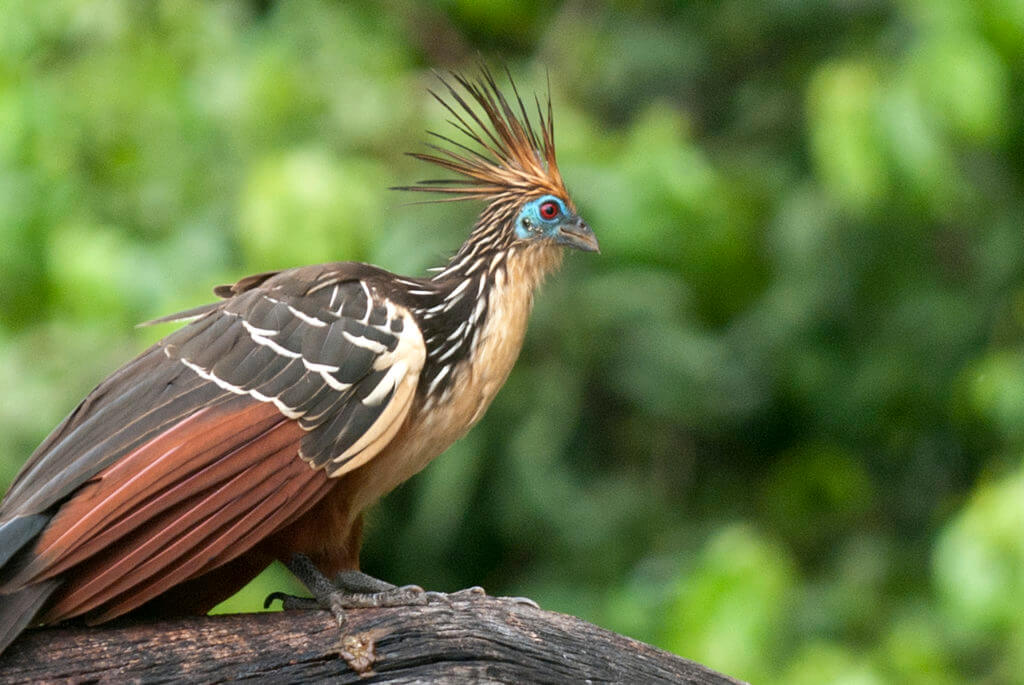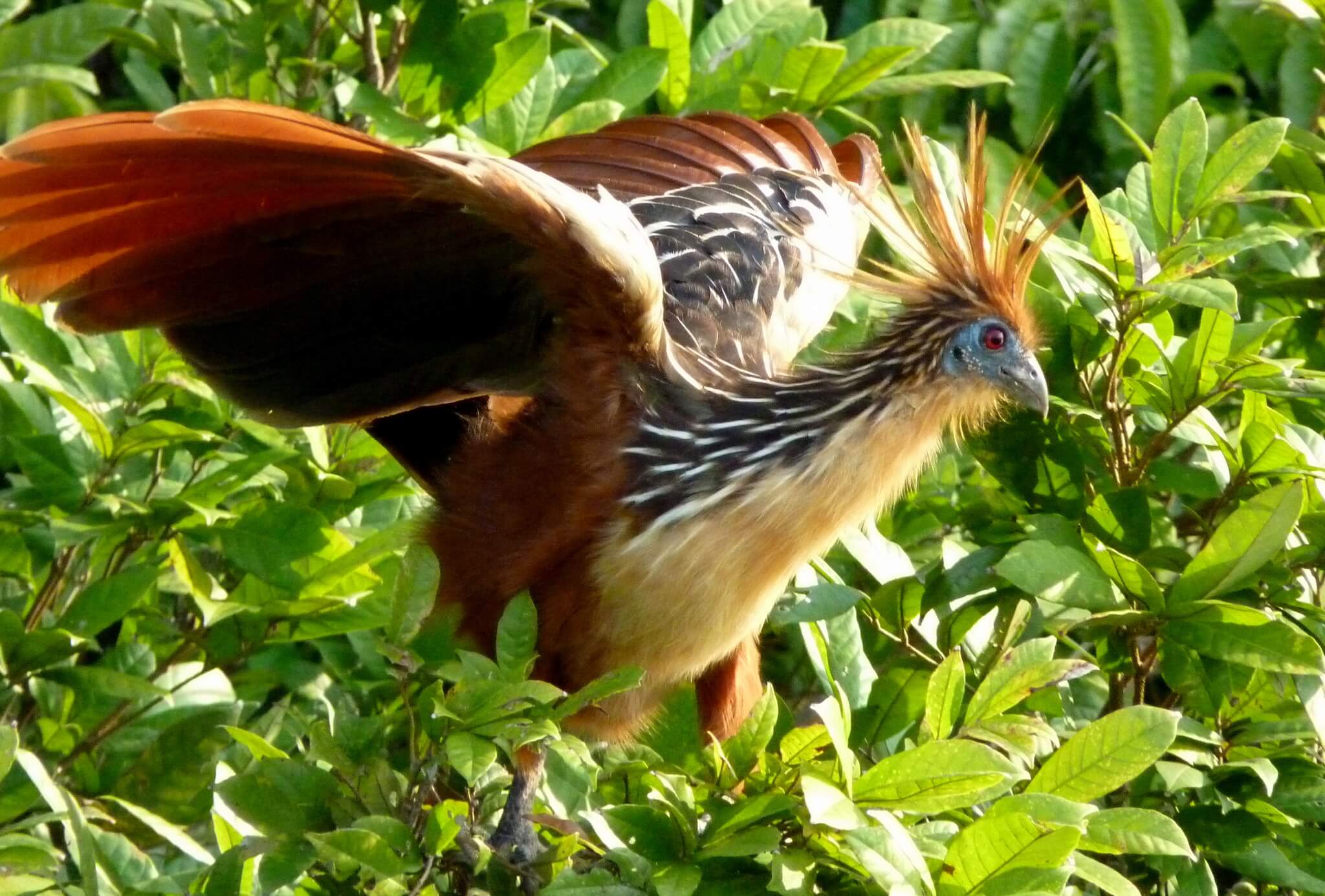The Hoatzin: Is It a Bird or a Cow?!

The hoatzin, or Opisthocomus hoazin, is such a special bird that it’s the only living species classified within the taxonomic family Opisthocomidae. Numerous studies have attempted to relate it to other groups of birds such as the Galliformes, Gruiformes, or cuckoo-doves. However, because of its unique anatomical and behavioral characteristics, they have decided to give the hoatzin its own family.
An inhabitant of the tropical swamps of the Amazon and Orinoco in South America, the hoatzin, like ruminant animals, ferments its food before it enters its stomach. Keep reading and discover in depth the characteristics of this peculiar specimen.
Physical characteristics of the hoatzin
As adults, male hoatzins reach an average size of 60 to 80 centimeters (24 – 32 inches) and females between 50 to 60 centimeters (20 to 24 inches). It has a slender and wide body, a long neck, and a small head. Its face doesn’t have any feathers, but has an intense blue coloration, while its eyes stand out for having a red iris.
Its head is adorned with a long, serrated, fan-shaped crest of chestnut tones. As for its extremities, this bird is anisodactyl, that is, it has three forward toes and one backward toe.
Even though it isn’t very good at flying, the hoatzin stands out for climbing trees with ease and for being a great swimmer. Finally, its song is composed of several strident and noisy sounds that resemble grunts.

A ruminant bird
Unlike other types of birds that have a diet based on various types of food, the hoatzin is characterized by being a strictly herbivorous animal. Its digestive system, which is unique among birds, evolved in such a way that it can break down the plant material it ingests.
Because this particular animal has anaerobic bacteria located in its digestive system, it can easily transform the polysaccharide cellulose into glucose. In other words, the hoatzin uses the bacterial fermentation method, just as some ruminants such as cows do to feed themselves.
Another rather curious fact is that this bird only consumes two types of plants in its natural habitat, the caladium, and the philodendron. In addition, because of its feeding habits, the hoatzin smells a bit like manure, which is why it’s known in some places as the “stinking turkey”.
Its young are a reminder of dinosaurs
Classified as a living fossil, everything involved in the hoatzin’s reproductive process is quite peculiar. On the one hand, being a gregarious animal, it builds its nests in small colonies, where there are several helpers who collaborate with the parents in the process of incubation, feeding, and defense of the young.
On the other hand, their nests, built with small branches, are located in trees over the water. They usually lay 2 to 3 eggs per clutch and, once they hatch, the chicks are fed with a vegetable paste regurgitated by the parents.
Similarly, these chicks retain a very striking feature that a group of prehistoric birds known as Archaeopteryx had. We’re talking here about two claws on the tips of each wing that help them to hold on to branches and climb them. However, these claws disappear as the bird grows into adulthood.

The hoatzin arrived from Africa
As described above, numerous studies have attempted to classify the hoatzin into any existing order or group of birds. However, by analyzing its physical, genetic, and behavioral characteristics, it has been concluded that it’s a unique species within the animal kingdom.
Until recently, the hoatzin was the only member of the family Opisthocomidae. However, thanks to a recent discovery published in the magazine Die Naturwissenschaften magazine, it was determined that this bird has an extinct relative.
It’s the Hoazinavis lacustris, a prehistoric bird that inhabited the Earth more than 20 million years ago. Its discovery, by Brazilian, French, and German paleontologists, was made in the state of São Paulo, Brazil.
This paper also puts forward a very solid theory about the origin of the hoatzin. According to this research, this bird isn’t native to South America, but it migrated directly from the African continent millions of years ago. According to this group of scientists, the hoatzin crossed this route aboard small rafts formed by plant remains and propelled by the winds and tides of the Atlantic.
Undoubtedly, this extravagant and particular species could be cataloged as one of the strangest birds on the planet. However, there are sure to be other even undiscovered animals that could be just as peculiar as the hoatzin!
All cited sources were thoroughly reviewed by our team to ensure their quality, reliability, currency, and validity. The bibliography of this article was considered reliable and of academic or scientific accuracy.
- Cracraft J. The Hoatzin. Current biology : CB. 2022;32(20):R1068-r9.
- Mayr G, Alvarenga H, Mourer-Chauviré C. Out of Africa: Fossils shed light on the origin of the hoatzin, an iconic Neotropic bird. Die Naturwissenschaften. 2011;98(11):961-6.
- Pacheco MA, García-Amado MA, Manzano J, Matta NE, Escalante AA. Blood parasites infecting the Hoatzin (Opisthocomus hoazin), a unique neotropical folivorous bird. PeerJ. 2019;7:e6361.
- Bardele CF, Schultheiß S, Lynn DH, Wright AG, Dominguez-Bello MG, Obispo NE. Aviisotricha hoazini n. gen., n. sp., the Morphology and Molecular Phylogeny of an Anaerobic Ciliate from the Crop of the Hoatzin (Opisthocomus hoazin), the Cow Among the Birds. Protist. 2017;168(3):335-51.
This text is provided for informational purposes only and does not replace consultation with a professional. If in doubt, consult your specialist.